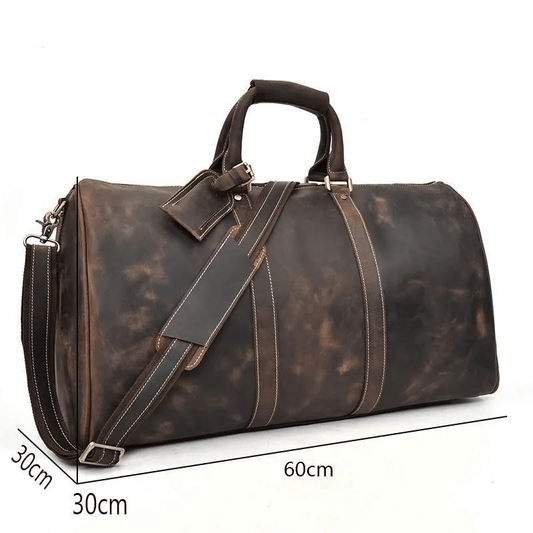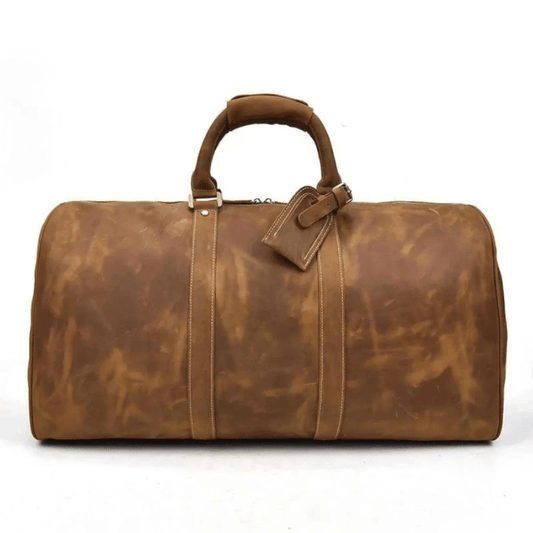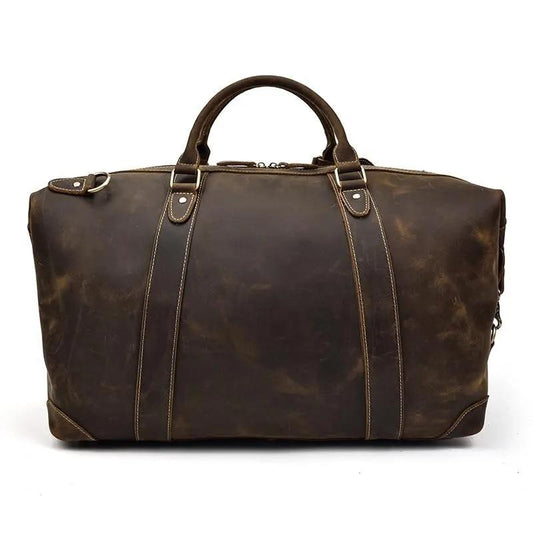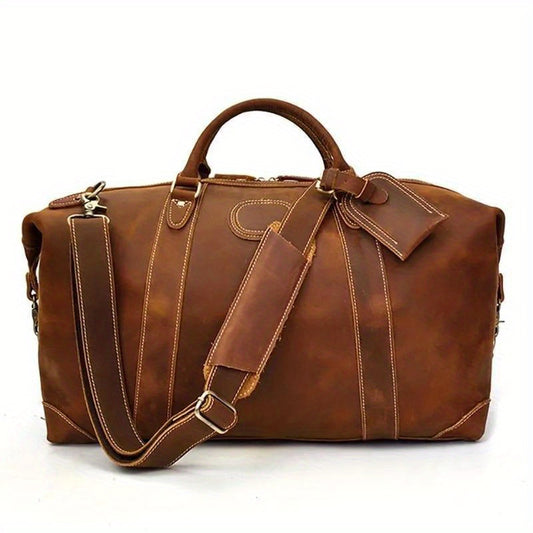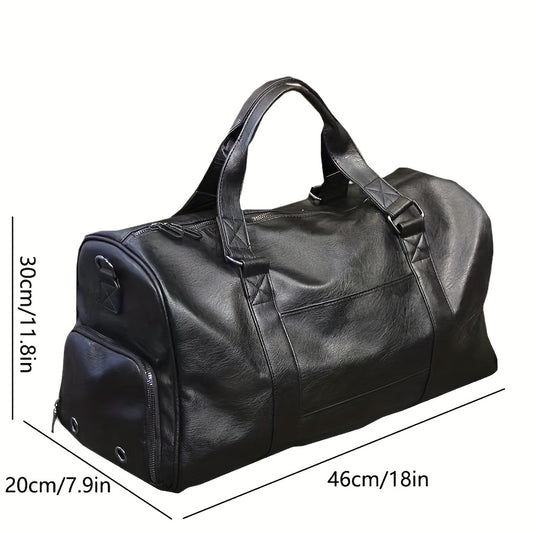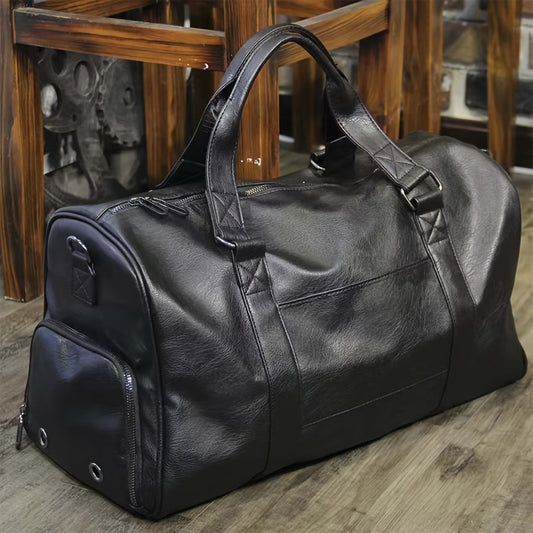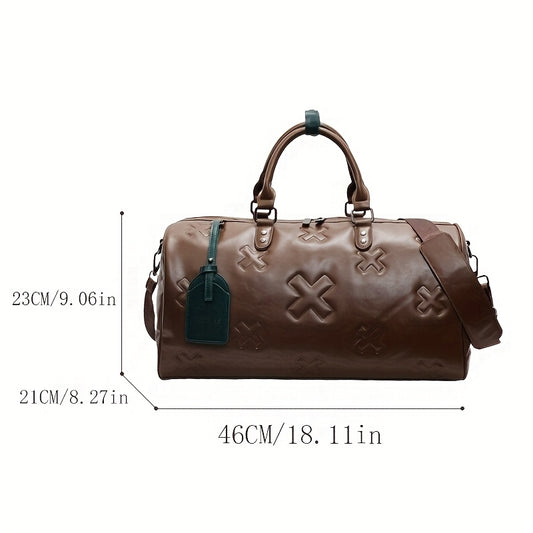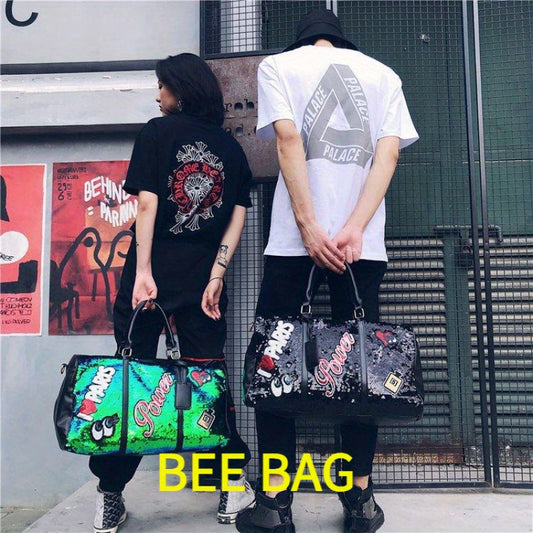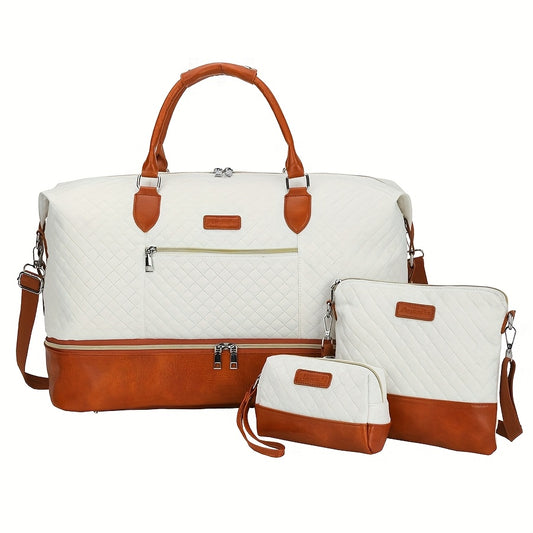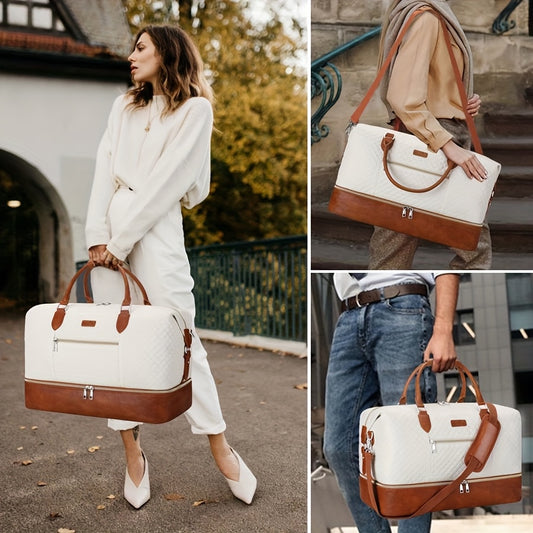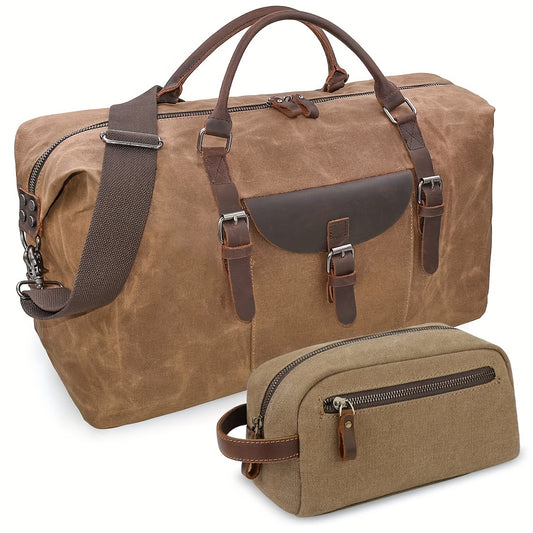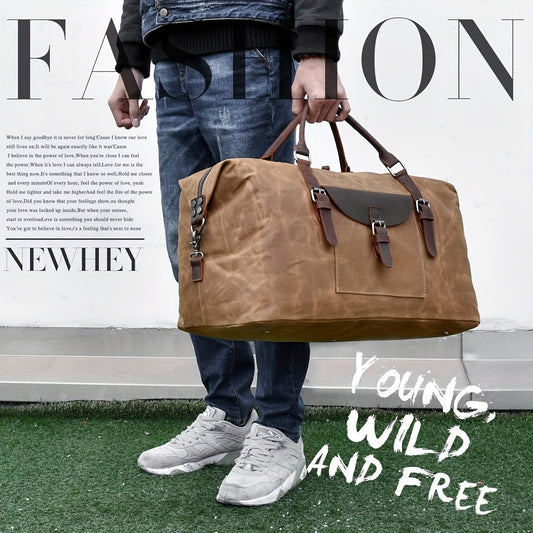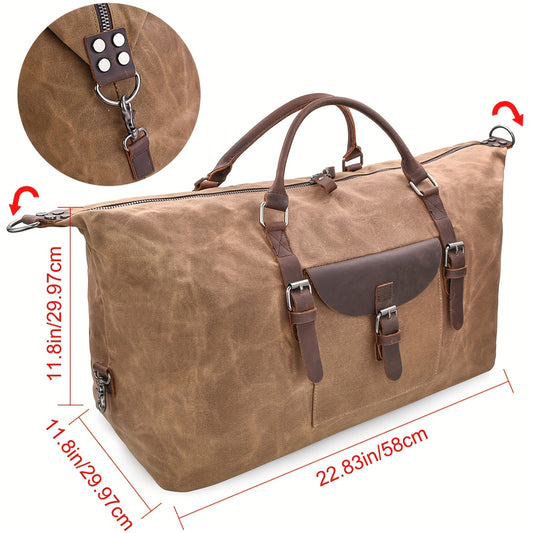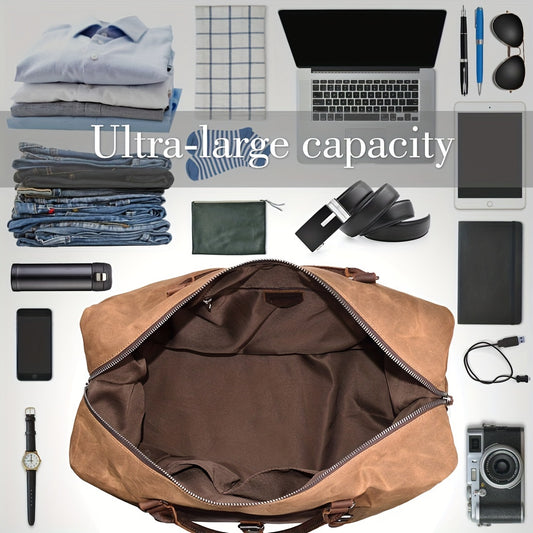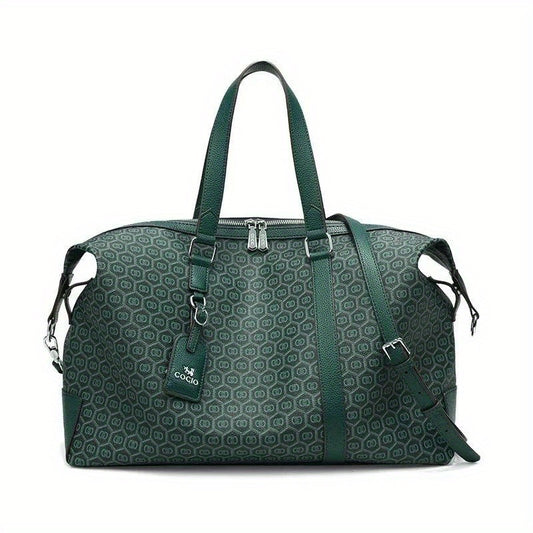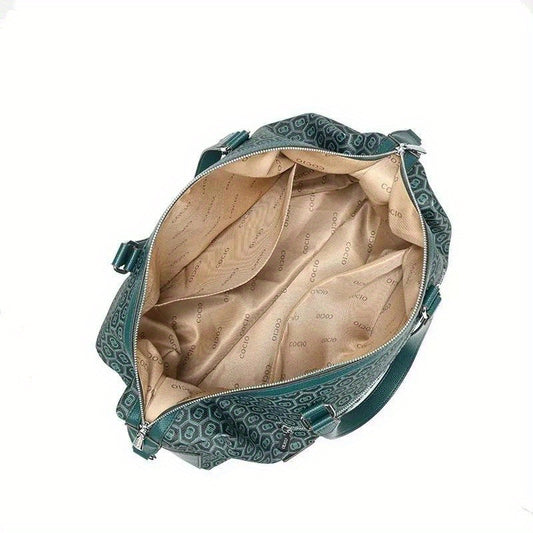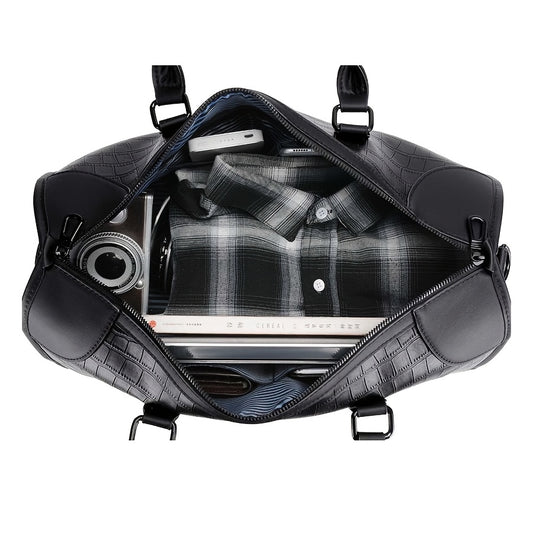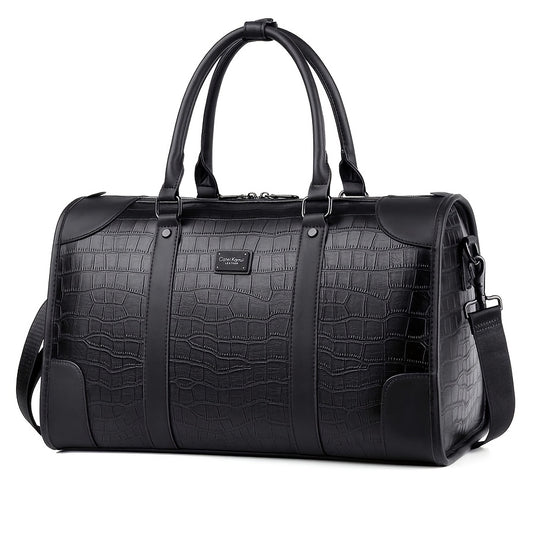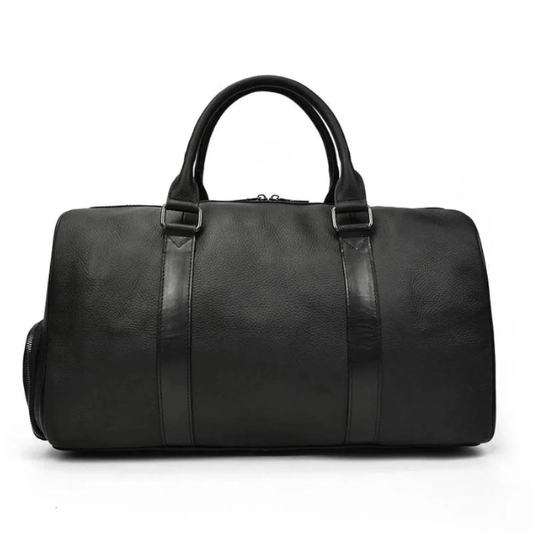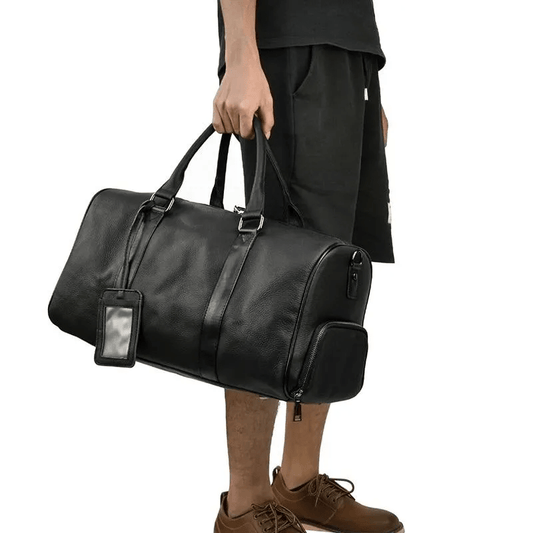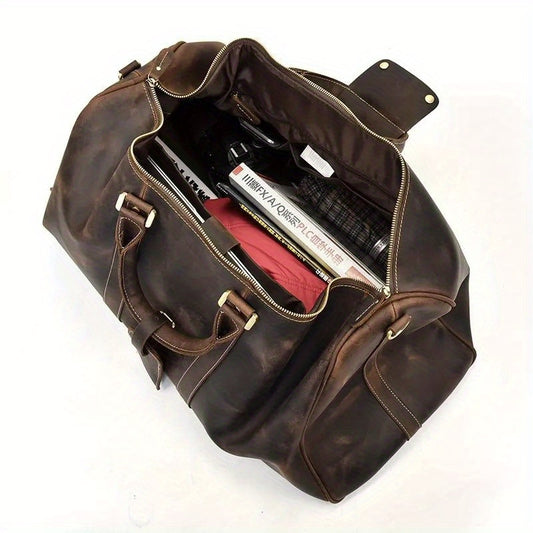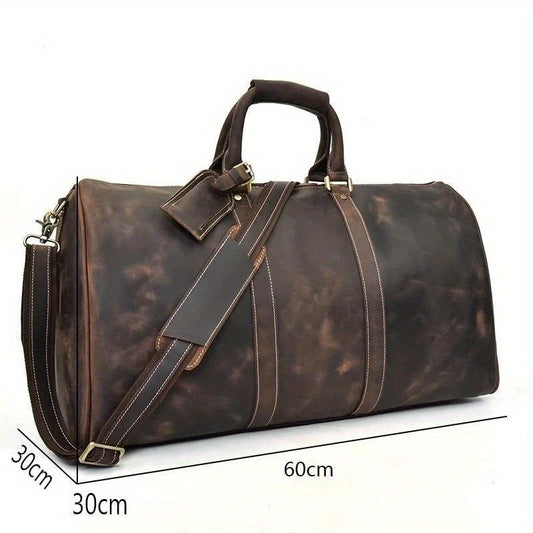The Complete Guide To Leather Handbags
Origins, Heritage, And The Essence Of Craft
Introduction To The Leather Handbag As A Luxury Icon
The leather handbag is not simply an accessory but one of fashion’s most enduring symbols of refinement. Its presence within global wardrobes is unmatched, offering both practicality and prestige. At its core, the leather handbag represents craftsmanship, material integrity, and the translation of function into form. Unlike garments that fluctuate with seasonal trends, a well-made leather handbag endures across decades, acquiring character with age. It serves as a vessel for essentials while simultaneously broadcasting status, taste, and identity. From streamlined totes to structured satchels, every silhouette reinforces the narrative that a handbag is both personal utility and cultural emblem.
The Heritage Of Leather As Material
Leather is one of humanity’s earliest textiles, chosen for its resilience and ability to adapt to diverse uses. Over centuries, it became a medium not only of protection but also of luxury. Tanning techniques evolved from rudimentary natural processes to advanced treatments that perfected texture and longevity. Full-grain hides, with their visible natural grain, exemplify authenticity, while top-grain leathers offer refinement through subtle finishing. Suede, nubuck, and patent finishes further expanded the vocabulary of leather, each serving distinct aesthetic and tactile needs. Luxury handbags elevate these leathers through artisanal cuts, careful stitching, and structural reinforcements that guarantee durability.
Evolution Into A Cultural Artifact
As society shifted from practical carrying pouches to fashion-forward accessories, the handbag became both a symbol and a necessity. In royal courts, bejeweled leather satchels signified rank. In the early modern period, urban life required compact bags for coins and personal items, transitioning over time into silhouettes resembling the modern handbag. Industrialization introduced precision in stitching and finishing, while global trade allowed diverse leathers—calfskin, lambskin, ostrich, and exotics—to enter ateliers. By the twentieth century, the leather handbag had transcended pure utility to become a cornerstone of style and identity, often carrying names of designers, houses, or artisans as cultural signatures.
The Language Of Design
The leather handbag speaks a language of form, proportion, and detail. Its silhouette can communicate authority, leisure, or glamour depending on structural choices. Structured totes emphasize professionalism, their clean lines signaling efficiency and control. Soft hobo bags highlight ease and fluidity, suited to relaxed lifestyles. Crossbody designs express practicality and movement, aligning with modern urban rhythms. Miniature handbags highlight fashion-forward boldness, while oversized weekenders suggest mobility and ambition. Handles, closures, and hardware further define the language: a top handle communicates heritage elegance, while adjustable straps signify versatility. Each design choice transforms leather into narrative.
Function As A Driver Of Luxury
The finest handbags do not sacrifice function for aesthetics. The arrangement of compartments, the calibration of straps, and the durability of stitching all shape daily experience. A zipper must glide effortlessly, a clasp must lock securely without strain, and handles must distribute weight without cutting into the hand. Interiors lined with suede or cotton drill protect belongings while elevating tactile pleasure. Structural reinforcement—hidden but essential—ensures that the handbag maintains silhouette through years of use. Luxury is not an excess of embellishment but the quiet assurance that every functional detail has been anticipated and perfected.
Materials And Their Aesthetic Impact
Each type of leather transforms a handbag’s identity. Calfskin offers supple smoothness with durability, making it the classic choice for structured handbags. Lambskin, softer and more delicate, conveys plush sophistication but requires careful handling. Pebbled leather adds texture and scratch-resistance, suited for everyday handbags that withstand frequent use. Suede introduces depth and matte elegance, while nubuck offers velvety tactility. Patent leather provides high-shine drama, especially in evening silhouettes. Exotic leathers such as crocodile or ostrich have historically embodied rarity, though modern markets emphasize ethical sourcing and traceability. Designers strategically pair leather type with silhouette to create handbags that embody both intent and mood.
Cultural Significance Across Eras
The handbag has always functioned as more than storage; it has been a cultural artifact. In different societies, it communicated wealth, discretion, or ceremonial importance. Today, it is a bridge across global cultures, representing empowerment and self-expression. For working professionals, a structured tote signals credibility in boardrooms. For travelers, a crossbody bag ensures mobility while maintaining style. For celebrants, a satin-lined evening clutch announces glamour. These cultural codes allow handbags to transcend trends, aligning instead with deeper expressions of identity.
Color, Finish, And Emotional Resonance
The choice of color and finish impacts both wearability and psychological presence. Black calfskin projects authority and remains the most versatile shade across climates and contexts. Earth tones such as tan, taupe, and cognac develop rich patinas over time, rewarding long-term ownership. Jewel tones—emerald, sapphire, garnet—introduce ceremonial presence for special occasions. White and ivory leathers offer modernist clarity but require careful maintenance. Metallic finishes, from gold patent to silver foils, inject glamour for evening use. Beyond visual impact, colors carry emotional resonance: red leather conveys confidence, blue suggests stability, and neutral browns embody grounded elegance.
The Rise Of The Leather Handbag In Luxury Markets
The twentieth and twenty-first centuries cemented the handbag as a pinnacle of luxury retail. Global maisons developed signature silhouettes recognizable at a glance, embedding them into collective imagination. Yet beyond labels, craftsmanship remained the decisive factor. Customers understood that quality stitching, calibrated hardware, and resilient leathers differentiated true luxury from mass-market imitations. Fabulive positions its leather handbag collections within this heritage of excellence, offering pieces that combine artisanal integrity with contemporary versatility.
Fabulive’s Commitment To Leather Handbag Excellence
Fabulive curates leather handbags with uncompromising attention to fabric pedigree, design refinement, and customer lifestyle needs. Collections emphasize full-grain and top-grain leathers, rejecting weak imitations. Hardware is selected for both tensile strength and aesthetic coherence, ensuring that zippers, clasps, and buckles serve as both functional and decorative elements. Interiors are carefully designed, with compartments structured to protect technology, cosmetics, and essentials while maintaining clean silhouettes. Each handbag undergoes meticulous inspection to confirm that stitching remains taut, linings secure, and proportions balanced. By prioritizing durability and design harmony, Fabulive ensures its handbags deliver long-term value.
Anatomy Of Design, Structural Engineering, And Material Science
The Architecture Of A Handbag
The design of a leather handbag begins not with decoration but with architecture. A bag is a three-dimensional object that must reconcile structure, proportion, and ergonomics. Designers work with templates, molds, and patterns that determine silhouette integrity. The height-to-width ratio impacts how the eye perceives balance: tall, narrow totes suggest verticality and authority, while wide, low satchels project grounded stability. Depth influences functionality—slimmer profiles offer elegance, but roomier gussets serve practicality. Every angle is intentional, from the slope of handles to the placement of seams, ensuring that the handbag performs as sculpture while serving as utility.
Core Silhouette Families
Luxury handbags fall into families of silhouette, each serving unique purposes. The tote emphasizes verticality and spaciousness, perfect for professionals carrying documents or technology. The satchel blends structure with formality, often with dual handles and a crossbody strap, bridging business and leisure. The hobo bag offers slouch and softness, aligning with weekend ease. The clutch distills the handbag into its most minimal form, suited for ceremonial or evening contexts. The crossbody prioritizes mobility, with adjustable straps for urban lifestyles. The duffel and weekender expand silhouettes into travel territory, balancing capacity with portability. Within each family, proportions vary, but the logic remains: every silhouette encodes lifestyle cues.
Handles, Straps, And Ergonomics
Carrying methods dictate daily interaction with handbags. Top handles evoke heritage elegance, requiring poise and presence. Shoulder straps convey informality and ease of motion, while crossbody straps suggest mobility and security. Adjustable systems—whether through buckles, sliders, or detachable clasps—transform a single handbag into multiple modes of use. Strap width is critical: narrow straps convey refinement but can dig into the shoulder under weight, while broader straps distribute pressure comfortably. Luxury design ensures not only visual harmony but also ergonomic integrity, so that handbags remain comfortable companions for extended use.
Closure Systems And Security
Closures are functional accents that shape both aesthetics and safety. The zipper remains the most secure, gliding along precision-engineered teeth that must never snag fabric or lining. Magnetic snaps offer speed and elegance, though they prioritize accessibility over full security. Turn-locks provide decorative detail while locking contents discreetly. Drawstring systems lend casual charm, especially in bucket bags, but rely on reinforced grommets to withstand tension. In luxury handbags, closures are tested repeatedly to confirm ease of use, durability, and alignment with the bag’s silhouette. Security, speed, and design must co-exist without compromise.
The Interior Landscape
The true measure of a handbag lies within. Interiors reveal how well designers anticipate the rhythms of daily life. Lining materials must balance softness with durability—suede exudes luxury but requires care, while cotton drill and microfiber blends offer resilience. Compartments divide belongings logically: padded sleeves for technology, zippered pockets for valuables, and open slots for cosmetics or keys. Hidden compartments lend discretion, while expandable gussets accommodate changing capacity needs. The interior architecture transforms the handbag from container into organizer, aligning function with elegance.
Hardware As Ornament And Structure
Metal components are more than embellishment; they are structural guardians. Handles are anchored by rivets or reinforced stitching, buckles adjust straps with mechanical precision, and feet at the base prevent leather scuffing. Luxury hardware is often plated in gold, palladium, or ruthenium, ensuring resistance to tarnish while maintaining refined sheen. Zippers must glide silently, their pull tabs ergonomic yet proportional. The scale of hardware determines mood: oversized clasps project boldness, while micro-fittings preserve minimalism. The harmony between leather and metal defines a handbag’s aura—robust yet polished, functional yet decorative.
Material Science And Leather Performance
Understanding leather requires fluency in material science. Full-grain leather retains the natural surface, displaying unique markings and offering maximum durability. Over time, it develops a patina that personalizes the bag. Top-grain leather undergoes surface refinement, balancing strength with smoothness. Corrected-grain leathers are embossed for uniformity but sacrifice authenticity. Suede and nubuck, sanded from the underside or surface of hides, deliver velvety tactility but demand protection against water and stains. Patent leather, with its glossy coating, achieves drama but requires careful storage. Modern tanneries now develop treated leathers resistant to scratches, spills, and UV fade, ensuring handbags withstand contemporary demands without losing elegance.
Structural Reinforcement
The silhouette of a handbag must survive years of carrying weight. Structural reinforcement is hidden but decisive. Cardboard stiffeners have been replaced in luxury production by bonded leather panels, thermoplastic inserts, or layered interfacing that retain shape without compromising flexibility. Seams are double-stitched at stress points, while handles may include steel cores wrapped in leather for resilience. Bottom panels are often reinforced with stiffened layers and protective feet. These unseen reinforcements transform leather into architecture, allowing the handbag to endure strain while preserving aesthetic precision.
Stitching Techniques And Precision
Stitching is the silent signature of quality. Saddle stitching, executed by hand with waxed thread, ensures each stitch is locked individually, preventing unraveling even if one thread breaks. Machine stitching offers efficiency but must maintain even tension to avoid puckering. Stitch per inch (SPI) is carefully calculated: too low, and seams weaken; too high, and leather risks tearing. Contrasting thread highlights craftsmanship, while tonal stitching emphasizes discretion. In luxury handbags, even the underside of seams and the interior finishing must reveal perfection. Customers instinctively recognize excellence when a handbag’s stitches read as rhythm rather than accident.
Color And Finish Techniques
The surface finish of leather transforms perception. Aniline dyes penetrate deeply, preserving natural grain and suppleness, though they reveal imperfections. Semi-aniline finishes balance durability with softness. Pigmented coatings create uniform color while protecting against stains. Metallic foils, embossing, and printed textures expand the visual vocabulary. Ombre shading and hand-painted edges demonstrate artisanal expertise. Luxury houses may employ edge-painting to seal raw cuts, preventing fray while adding contrast. The science of finishing ensures leather resists wear while amplifying beauty.
The Balance Of Weight And Comfort
A handbag must balance durability with portability. Excessive weight, even from high-quality leather, diminishes usability. Designers calculate material thickness, hardware density, and reinforcement weight to achieve equilibrium. Lightweight linings, hollow hardware, and calibrated gussets ensure handbags remain comfortable even when fully loaded. Luxury design is not about heaviness but about proportionate balance—creating objects that feel substantial yet never burdensome.
Innovation In Leather Treatments
Modern innovation has expanded what leather handbags can achieve. Water-resistant coatings protect against rain without altering texture. Scratch-resistant finishes preserve smooth leathers against daily abrasion. Sustainable tanning methods reduce chemical impact while delivering consistent coloration. Some leathers now integrate recycled content, offering eco-conscious luxury without sacrificing performance. These treatments allow handbags to align with modern values of responsibility while preserving timeless aesthetics.
Fabulive’s Dedication To Design Integrity
Fabulive integrates every element of design anatomy with care. Patterns are cut to minimize waste while maximizing grain continuity. Handles are proportioned for ergonomic carry, closures selected for durability, and hardware plated for longevity. Interiors are designed for real lives—organized compartments, protective linings, and secure pockets. Stitching is inspected for precision, ensuring handbags maintain integrity under repeated use. By treating design as architecture, Fabulive ensures each leather handbag is not only an accessory but a lifetime companion, balancing beauty with resilience.
Functionality, Cultural Relevance, And Global Lifestyles
Function As The Core Of Luxury
A handbag earns its place in daily life not by appearance alone but by how it functions. Luxury is defined by anticipation of need: the ease with which a clasp opens, the assurance that a strap distributes weight, the knowledge that compartments are calibrated for essentials. A well-designed tote accommodates laptops without losing silhouette; a satchel protects documents from creasing; a crossbody bag allows movement through crowded cities while keeping valuables secure. In this context, luxury does not mean excess decoration but the refinement of utility into elegance. Each decision, from zipper glide to interior lining, is functional design elevated into art.
The Professional Handbag
In corporate and professional spaces, the handbag is a subtle yet powerful signal of credibility. Structured totes and satchels dominate here, their geometry reinforcing authority. Interiors provide padded sleeves for technology, while exteriors remain sleek to project polish. Neutral tones such as black, cognac, and navy are preferred for their gravitas, though modern professionals increasingly embrace muted jewel tones that maintain seriousness while offering individuality. Handles and straps must transition from hand carry to shoulder with equal grace, allowing mobility without compromising authority. The professional handbag is not just a container; it is part of the visual grammar of leadership.
The Travel Companion
For travelers, the handbag becomes a performance object. Weekenders and duffels must combine capacity with portability, their leather resistant to abrasion while interiors are lined for protection. Crossbody bags serve as secure companions during city exploration, offering hands-free mobility. Zippered closures protect passports and currency, while multiple compartments organize essentials for quick access. Travel handbags are increasingly made from treated leathers resistant to moisture, stains, and scratches, ensuring that they withstand diverse climates. The aesthetic must remain refined; a luxury handbag should signal cosmopolitan ease whether carried through airport lounges, boardwalks, or urban streets.
The Evening Statement
Evening handbags shift the vocabulary of leather from practical to ceremonial. Clutches, minaudières, and small top-handle bags emphasize proportion, designed to carry only essentials: a lipstick, keys, a compact phone. Materials such as patent leather, metallic foils, or satin-lined calfskin transform the silhouette into ornament. Embellishments—beading, crystals, or hand-painted finishes—add luminosity. In this context, the handbag functions less as storage and more as punctuation, completing formal ensembles with sculptural clarity. The evening bag’s value lies not in capacity but in presence.
Casual And Weekend Logic
Soft hobo bags, slouchy crossbodies, and mid-sized totes dominate weekend wardrobes. Their flexibility signals leisure, their textures softer, their tones warmer. Pebbled or grained leathers offer resilience against scratches, while suede accents provide relaxed sophistication. Interiors remain organized but not rigid, allowing for spontaneous use: carrying books, market finds, or children’s accessories. Casual handbags emphasize comfort without neglecting refinement, ensuring that leisure remains stylish rather than careless.
Cultural Significance Across Regions
Leather handbags resonate differently across geographies. In Europe, the structured tote is linked with minimalism and heritage craftsmanship. Italian ateliers favor vegetable-tanned leathers in earthy palettes, while French maisons emphasize slim silhouettes in jewel tones. In the Middle East, oversized totes and embellished evening clutches dominate, reflecting both practicality and celebratory grandeur. North America prizes functionality—backpacks and crossbody bags for urban mobility, weekenders for road trips. In Asia, compact structured bags appeal to metropolitan professionals who balance space efficiency with elegance. Africa’s markets integrate vibrant colors and textured leathers, reflecting artisanal heritage. Each region demonstrates how the handbag adapts to cultural needs while maintaining universal prestige.
Symbolism And Identity
The handbag is more than a carrier of belongings; it is a container of identity. Women describe their handbags as personal sanctuaries, storing objects that support daily performance. Beyond utility, the handbag projects self-image. A minimalist black tote signals restraint, a jewel-toned satchel expresses confidence, and an oversized crossbody conveys dynamism. In luxury contexts, handbags function as both silent companions and visible declarations, signaling taste, lifestyle, and aspiration. Cultural codes further influence meaning: in some societies, the handbag represents independence; in others, it reflects familial or ceremonial values.
Gender And Handbag Evolution
Historically associated with women, handbags are increasingly crossing gender boundaries. Men’s leather totes, satchels, and crossbody bags have gained prominence, reflecting shifts in workplace norms and fashion inclusivity. Compact messenger bags serve professionals, while structured backpacks integrate seamlessly with formal attire. The rise of gender-neutral silhouettes demonstrates that functionality and style are universal needs. Fabulive’s curation acknowledges this expansion, offering designs that emphasize craftsmanship over gender coding, making leather handbags accessible to broader demographics.
Emotional Resonance Of Ownership
Owning a leather handbag is not simply about possession but about relationship. Clients describe the satisfaction of breaking in new leather, watching it develop a patina, and carrying it through significant life events. A first professional tote may symbolize entry into a career, while a bridal clutch becomes part of wedding memories. Handbags carry emotional weight as they accompany milestones: travel, ceremonies, promotions, and daily rituals. Over time, they embody not just style but personal narrative, becoming companions that hold both objects and stories.
Technology Integration
Modern life demands handbags that integrate seamlessly with technology. Padded compartments for laptops, tablets, and smartphones are no longer optional but essential. Charging ports and cable pass-throughs are appearing in advanced designs, while RFID-protected pockets safeguard data security. Luxury handbags now balance artisanal craft with technological utility, ensuring that traditional materials like calfskin adapt to digital age requirements. This synthesis reflects the handbag’s role as both historical artifact and contemporary tool.
Security As Lifestyle Assurance
Security is integral to functionality. Zippers must resist tampering, magnetic closures must lock reliably, and hidden compartments must protect valuables. Crossbody bags are favored in urban environments for their close-body security, while totes benefit from zipped central compartments. In travel contexts, passport-sized slots and reinforced zippers provide reassurance. Luxury handbags integrate these security features discreetly, ensuring they enhance rather than detract from aesthetics. Safety is built into design so subtly that it becomes invisible yet indispensable.
The Handbag In Ritual And Ceremony
Leather handbags are often chosen for ceremonies, where they symbolize dignity and polish. Weddings, graduations, and cultural festivals see handbags elevated into ornamental objects. Evening clutches with metallic finishes, embossed calfskin minaudières, and hand-beaded leather purses become markers of status and celebration. In these contexts, handbags are less about practicality than about cultural presence, completing ensembles that carry emotional and symbolic weight. Their significance extends beyond fashion—they become artifacts of memory preserved through photography and tradition.
Fabulive’s Functional And Cultural Vision
Fabulive curates handbags that balance cultural awareness with universal functionality. Structured totes are engineered for professional authority, oversized weekenders designed for mobility, and clutches refined for ceremonial use. Leathers are selected for resilience and tactility, while interiors are tailored to modern technology. Fabulive’s commitment ensures that handbags serve not only as style accessories but as global lifestyle companions, resonating with cultural contexts while upholding luxury standards.
Styling Strategies, Accessory Coordination, And Occasion Dressing
The Handbag As A Styling Anchor
Within the architecture of personal style, the handbag operates as anchor and amplifier. It is often the first element noticed, setting tone before garments or jewelry. A structured leather tote in neutral shades projects discipline, instantly aligning its owner with authority. A jewel-toned crossbody injects personality into otherwise minimal outfits, while a metallic clutch punctuates evening ensembles with glamour. Styling with handbags is not an afterthought but an intentional act of visual composition, balancing proportion, color, and material.
Day-To-Night Transitions
One of the handbag’s most valuable functions is its ability to reprogram an outfit across time. During the day, a professional may carry a black calfskin tote with polished hardware, coordinating with a tailored suit. As evening approaches, replacing the tote with a satin-lined clutch transforms the same ensemble into formalwear. In casual wardrobes, a neutral crossbody can accompany errands, then be swapped for a bold-hued mini bag to reframe the look for dinner. Strategic curation ensures transitions are seamless, maximizing wardrobe efficiency without compromising style.
Color Coordination And Emotional Tone
Color determines resonance. Neutral handbags in black, taupe, or ivory provide universal compatibility, forming the backbone of any collection. Earth tones such as cognac or chestnut evoke warmth and maturity, while jewel tones deliver drama for ceremonial settings. Metallic leathers project festivity, and pastels align with spring wardrobes. Designers use color to modulate emotion: red leather signals confidence, navy conveys professionalism, and white suggests modern clarity. Clients who curate intentional palettes achieve coherence across seasons, ensuring each handbag integrates with clothing capsules rather than standing alone.
Proportion And Scale Management
Proportion defines whether a handbag complements or overwhelms. Petite clients benefit from mid-sized crossbodies or compact satchels that align with body scale, while oversized totes can appear unbalanced. Taller clients command larger silhouettes effortlessly, allowing for dramatic hobos or oversized clutches. Structured mini bags, though small, can serve as bold focal points when paired with streamlined garments. Proportion also influences context: oversized bags appear casual, while smaller structured designs read as formal. Mastering proportion ensures handbags operate harmoniously within the visual composition of an outfit.
Seasonal Styling Strategies
Seasonality influences material and mood. Spring favors pastel satchels, perforated leathers, and lightweight crossbodies. Summer emphasizes woven accents, suede trims, and bright colors that resonate with vacation wardrobes. Autumn welcomes rich earth tones—burgundy, olive, cognac—paired with heavier textures like pebbled or grained leather. Winter elevates handbags into sculptural accessories: black patent clutches, structured totes in dark hues, and velvet-embellished crossbodies. Seasonal curation ensures handbags evolve with wardrobes, creating rhythm across the year while reinforcing continuity of style.
Professional Codes And Styling Logic
Within workplaces, handbags carry authority beyond utility. A matte black or navy tote pairs with tailored blazers, while muted jewel tones such as deep emerald or garnet express individuality without undermining professionalism. Polished hardware signals refinement, while minimal decoration preserves seriousness. Proportions remain structured: slouch is reserved for leisure. Styling logic dictates that professional handbags complement, not compete with, garments. Coordinated footwear and belts enhance authority, ensuring the handbag functions as part of a coherent visual system rather than an isolated accessory.
Weekend And Leisure Capsules
For weekends, handbags must embody ease without compromising sophistication. Slouchy hobo bags in pebbled leather align with denim, cotton dresses, and relaxed footwear. Crossbody bags in lighter colors free the hands while maintaining polish, pairing naturally with espadrilles or sneakers. Totes in canvas-leather hybrids provide resilience for markets or travel, while still anchored by leather handles and trims for refinement. Weekend handbags prioritize comfort, but in luxury contexts, they remain elevated—ensuring leisure reads chic rather than careless.
Evening And Formal Styling
Evening handbags operate as sculptural jewelry. Compact clutches, satin-lined minaudières, and metallic leather purses become focal points, chosen to harmonize with gowns and tailored evening suits. Embellishments—beading, embroidery, or crystal clasps—add luminosity. Color often contrasts rather than blends: a black gown may be punctuated by a ruby red clutch, while a neutral dress gains energy from metallic gold. Evening styling demands balance between restraint and presence; the handbag is minimal in size yet maximal in impact, completing ensembles with deliberate punctuation.
Accessory Coordination As System
The handbag rarely functions alone; it exists within an ecosystem of accessories. Belts, shoes, jewelry, and scarves either coordinate directly or contrast strategically. Matching handbag and footwear remains timeless, though modern styling often favors tonal coordination—different shades within the same color family. Jewelry interacts with handbag hardware: gold clasps pair naturally with gold earrings, while silver zippers harmonize with platinum or white-gold pieces. Scarves can be looped around handles for added texture, while brooches or charms personalize without undermining integrity. Accessory coordination is system design: each piece strengthens coherence, ensuring the whole is greater than the sum.
Photography And Digital Presence
Styling handbags today extends into digital spaces where photography and video dominate. Matte leathers photograph cleanly under natural light, while patent finishes catch and amplify illumination. Engineered proportions ensure handbags frame rather than distort body scale in images. Digital visibility has elevated handbags into symbolic shorthand: a well-chosen leather bag communicates polish across platforms instantly. Clients conscious of their digital presence select handbags that photograph as well as they perform physically, ensuring continuity of elegance both online and offline.
Styling For Diverse Climates
Climate alters styling priorities. In humid regions, lighter colors and breathable linings are prioritized, preventing discomfort from prolonged contact with the body. In colder climates, darker structured handbags withstand precipitation while pairing with heavy coats and boots. Desert environments favor lighter leathers that reflect heat, while urban temperate regions allow more experimental palettes. Climatic logic ensures handbags not only integrate aesthetically but also perform sensibly, aligning lifestyle with geography.
Fabulive’s Styling Philosophy
Fabulive treats handbags not as isolated accessories but as styling anchors. Collections are curated to offer clients coherent capsules: neutral totes for professional spaces, slouchy hobos for weekends, jewel-toned clutches for ceremonies, and structured satchels for daily polish. Each design is vetted for proportion, ensuring harmony with diverse body types. Colors are edited into versatile palettes that integrate with wardrobes across seasons. Accessory logic is emphasized, with hardware finishes chosen to harmonize with jewelry and footwear. Fabulive’s philosophy is not about excess but about precision: providing handbags that amplify style with clarity and longevity.
Maintenance, Sustainability, And Investment Value
The Role Of Care In Longevity
A leather handbag’s ability to endure across decades depends on disciplined maintenance. Leather is a living material; it breathes, absorbs, and evolves, acquiring patina over time. Proper cleaning preserves suppleness and prevents cracks. Dust should be removed with soft cloths, and stains addressed immediately with appropriate leather cleansers. Oily marks respond to absorbent powders like cornstarch, while water stains fade with gradual drying away from direct heat. Conditioning every few months restores natural oils, preventing brittleness. Luxury leather must never be over-saturated; subtle hydration maintains elasticity without weakening fiber structure. Handbags that receive consistent care become heirloom objects rather than disposable accessories.
Storage Principles For Protection
Storage routines protect leather from distortion and environmental stress. Handbags should be emptied, gently stuffed with acid-free tissue to preserve shape, and stored in breathable dust bags. Plastic coverings are avoided, as they trap moisture and encourage mildew. Handles benefit from being wrapped with soft cloth to prevent strain or color transfer. Vertical stacking is discouraged; instead, handbags are aligned upright with space between them to avoid scuffing. In humid climates, silica gel packets absorb excess moisture, while in dry environments, conditioning helps counter cracking. Seasonal rotation further extends lifespan, allowing handbags to rest in controlled conditions when not in frequent use.
Repair And Restoration
Even the most carefully handled handbag may require restoration over time. Edge paint can chip, zippers may dull, and linings can fray. Luxury ateliers specialize in these repairs, reinforcing Fabulive’s commitment to long-term service. Scratches can be reduced through polishing, corners reinforced with patching, and hardware re-plated to restore luster. Suede surfaces are revived with brushing, while faded leather can be recolored using artisanal dyes. Skilled restoration does not merely repair but renews, allowing handbags to re-enter circulation for years. For clients, this assures that investment pieces remain relevant and beautiful long after purchase.
Sustainability In Material Choice
Sustainability begins with leather sourcing. Full-grain hides selected as by-products of the food industry ensure ethical responsibility, diverting waste from landfills. Vegetable tanning, using natural tannins from bark and leaves, minimizes chemical runoff compared to chrome tanning. Sustainable leathers embrace traceability, where every hide’s origin is documented. Alternative leathers—piñatex from pineapple fibers, mycelium-based innovations, or recycled leathers—expand ethical vocabulary, offering resilience while reducing environmental burden. For luxury, authenticity and sustainability are not contradictory; they coexist when material sourcing respects ecosystems and communities. Fabulive prioritizes these responsible approaches, ensuring its handbags align with modern values of stewardship.
Reducing Environmental Impact In Production
Production processes influence ecological footprint. Digital cutting reduces waste by optimizing hide use, while water-efficient tanning reduces consumption. Non-toxic dyes ensure safety for both artisans and end users. Energy-efficient machinery minimizes carbon emissions, and recyclable packaging reduces post-purchase waste. Luxury brands adopting circular systems, including repair services and resale platforms, extend product lifecycles and reduce unnecessary production. By combining artisanal methods with technological efficiency, handbags achieve sustainability without losing the tactile richness of craft. Fabulive integrates these strategies, privileging longevity over volume.
Investment Logic And Cost Per Wear
The true measure of luxury lies in value over time, not cost at purchase. A well-made handbag amortizes its expense across years of wear, reducing cost per use dramatically compared to disposable fast-fashion alternatives. A structured tote in full-grain calfskin may serve daily professional needs for a decade, outlasting cheaper imitations that deteriorate within months. Neutral palettes and timeless silhouettes further extend relevance, ensuring handbags resist obsolescence. Clients who calculate cost per wear discover that investing in Fabulive’s handbags yields both financial and aesthetic dividends, blending rationality with pleasure.
The Heirloom Dimension
Leather handbags acquire meaning as they pass through generations. A mother’s satchel becomes a daughter’s daily companion, its patina recording decades of shared history. A bridal clutch transforms into an heirloom, carried at anniversaries or family celebrations. Luxury handbags are designed with this horizon in mind—stitching intended to endure, leathers that mature rather than degrade, and hardware that can be restored. Heirloom logic elevates the handbag from fashion object to cultural artifact, embedding it within family narratives and shared memory.
Minimalism And Capsule Efficiency
Responsible luxury aligns with minimalism. Rather than accumulating excess, clients benefit from curated capsules of handbags designed for versatility. A neutral structured tote covers professional needs, a crossbody supports travel and casual dressing, a jewel-toned clutch addresses formal occasions, and a weekender accommodates journeys. Four to five handbags, chosen intentionally, replace dozens of disposable alternatives. Capsule efficiency reduces environmental footprint while ensuring every piece receives regular use. Fabulive encourages this philosophy, curating handbags that anchor wardrobes with precision rather than clutter.
Traceability And Ethical Transparency
Modern consumers demand transparency, seeking assurance that their purchases align with ethical standards. Traceability involves documenting each step: hide sourcing, tanning, cutting, stitching, and finishing. Fair labor practices ensure artisans receive equitable compensation, safe working environments, and recognition for their craft. Transparency builds trust, demonstrating that luxury is not indulgence but responsibility. Fabulive champions this ethos, publishing information on sourcing, methods, and community engagement. By aligning beauty with ethics, the brand transforms ownership into an act of conscious choice.
The Circular Future Of Luxury Handbags
Sustainability extends beyond first ownership. Resale platforms, rental services, and refurbishment programs extend the lifecycle of handbags, reducing demand for new production. Circular models allow handbags to move fluidly between owners, each adding new layers of narrative. Luxury handbags lend themselves to this system because their construction withstands decades. Fabulive’s investment in restoration and aftercare services ensures its handbags remain desirable in both first and secondary markets. Circularity becomes the next frontier of luxury—preserving heritage while reducing waste.
Fabulive’s Responsibility In Luxury Stewardship
Fabulive interprets sustainability as stewardship. By sourcing responsibly, designing timelessly, and supporting aftercare, it ensures handbags embody both elegance and ethics. Clients can trust that each purchase aligns with long-term value, environmental responsibility, and cultural respect. This philosophy positions Fabulive not only as a curator of luxury handbags but also as a leader in shaping a more sustainable future for the industry.
Long-Term Value, FAQs, And Customer Perspectives
The Enduring Value Of Leather Handbags
Leather handbags endure because they unite permanence with adaptability. Unlike garments prone to seasonal obsolescence, a well-constructed handbag retains relevance across decades. Full-grain leather matures gracefully, developing patina that narrates personal journeys. A structured tote from the early 2000s still conveys authority in contemporary offices, while a jewel-toned clutch purchased for a wedding remains striking at anniversaries years later. Longevity is not incidental but engineered: stitching locked against unraveling, hardware plated for resistance, leathers treated for durability. Clients investing in Fabulive’s handbags secure companions that evolve rather than expire, affirming luxury as permanence rather than novelty.
Handbags As Personal Archives
Every handbag functions as an archive of memory. A crossbody carried through university years becomes a symbol of independence. A bridal clutch recalls vows and ceremonies. A professional tote reflects promotions and boardroom achievements. The handbag holds not only objects but experiences, becoming a tactile record of milestones. When properly maintained, these handbags transition into heirlooms, carrying narratives from one generation to another. Ownership becomes legacy, and leather becomes vessel for personal and cultural history.
Inclusivity And Accessibility
Luxury handbags must not exclude; they must serve diverse bodies, lifestyles, and climates. Inclusivity emerges in strap lengths adjustable for varied heights, silhouettes designed for petite or tall frames, and palettes broad enough to suit different complexions. Accessibility is furthered by transparent sizing, clear product details, and thoughtful pricing strategies that respect long-term value. Fabulive’s curation emphasizes this inclusivity, ensuring that every client—whether professional, traveler, or celebrant—finds designs aligned with both lifestyle and aspiration.
Frequently Asked Questions
What type of leather lasts longest? Full-grain leather is the most durable, retaining natural grain and developing patina over time. Are leather handbags suitable for humid climates? Yes, provided they are stored properly with moisture absorbers and conditioned to prevent mildew. How many handbags should form a capsule collection? Four to five carefully chosen designs cover most scenarios: a tote, a crossbody, a clutch, a weekender, and an additional seasonal piece. Can leather handbags be eco-friendly? Absolutely—vegetable-tanned leathers, recycled leathers, and by-product sourcing align handbags with sustainability. How do I maintain hardware shine? Clean gently with microfiber cloths and avoid harsh chemicals; professional re-plating restores luster when needed. Are suede and nubuck practical? Yes, when treated with protective sprays and rotated strategically rather than used daily in adverse climates. Do handbags integrate with digital lifestyles? Modern designs include padded laptop sleeves, RFID pockets, and even charging compartments. How do I prevent sagging in soft bags? Use bag shapers or tissue stuffing during storage to maintain silhouette. What is the difference between pebbled and smooth leather? Pebbled leather offers resilience against scratches; smooth leather projects elegance but requires more careful handling. What makes Fabulive’s handbags distinctive? They emphasize full-grain and top-grain leathers, precise architecture, functional interiors, sustainable sourcing, and meticulous finishing—elevating everyday utility into refined luxury.
Fabulive’s Vision For Continuity
Fabulive treats each handbag as an investment in continuity. Collections are curated for timeless silhouettes rather than fleeting trends, ensuring relevance across wardrobes and years. Transparency in sourcing ensures that beauty is matched by ethics, while aftercare guidance extends lifespan. By privileging responsibility, quality, and versatility, Fabulive’s handbags become more than accessories—they are partners in life’s journey, companions that adapt to professional, casual, and ceremonial contexts.
Customer Reviews
• “I purchased a structured tote from Fabulive in black full-grain leather for my new role in New York. It carried my laptop and documents daily, yet it has never lost its shape. The handles are perfectly balanced, and even after a year of constant use the stitching remains flawless. It’s a handbag that projects authority without being ostentatious.” – Rachel, USA ⭐⭐⭐⭐⭐
• “For my honeymoon in Florence, I wanted a weekender that looked refined yet practical. Fabulive’s cognac leather duffel was perfect. It fit everything I needed, survived airports and train rides, and still looked polished at luxury hotels. The patina developing now makes it even more beautiful.” – Elena, Italy ⭐⭐⭐⭐⭐
• “I was nervous about suede maintenance, but Fabulive’s deep emerald suede satchel came pre-treated with protection. I wore it through London’s damp autumn, and it resisted stains while remaining supple. It pairs elegantly with both workwear and casual outfits. Truly impressive craftsmanship.” – Amelia, UK ⭐⭐⭐⭐
• “Living in Dubai, I need handbags that withstand heat. My Fabulive top-handle bag in taupe calfskin held up perfectly. The leather did not crack, the lining stayed intact, and it became my constant companion for business meetings. It reflects understated luxury.” – Samira, UAE ⭐⭐⭐⭐⭐
• “I travel often between Toronto and Vancouver, so functionality matters. The Fabulive crossbody I bought was lightweight, organized, and secure with RFID pockets. It kept me mobile without sacrificing elegance. It shows that thoughtful design makes life easier.” – Amina, Canada ⭐⭐⭐⭐⭐
• “At my daughter’s wedding, I carried a ruby red Fabulive clutch with metallic hardware. It was compact yet striking, and it became a talking point at the event. Even in photographs years later, it looks as timeless as the day I bought it.” – Sofia, Spain ⭐⭐⭐⭐⭐
• “My Fabulive satchel has become my everyday bag in Sydney. The pebbled leather hides small scratches, and the compartments are smartly arranged. I appreciate how it balances resilience with elegance. Even casual errands feel elevated with this bag.” – Hannah, Australia ⭐⭐⭐⭐
• “The craftsmanship of my navy tote from Fabulive exceeded expectations. The hardware feels solid, the edges are painted cleanly, and the interior is thoughtfully structured. It feels like an object built to last decades, not years. Worth every cent.” – Clara, France ⭐⭐⭐⭐⭐
• “I bought a patent leather clutch for gala dinners in Munich. The shine was dramatic but refined, and the clasp worked smoothly without fail. It became my signature piece for formal events. It’s rare to find handbags that feel both artistic and dependable.” – Marta, Germany ⭐⭐⭐⭐
• “Although I initially found the price high, my Fabulive tote proved its worth. It has survived commutes in rain, flights across Asia, and endless meetings. It still looks sophisticated, and I know I will carry it for many years. That is the essence of investment luxury.” – Noor, Malaysia ⭐⭐⭐⭐⭐

